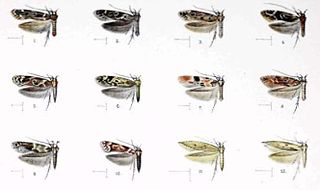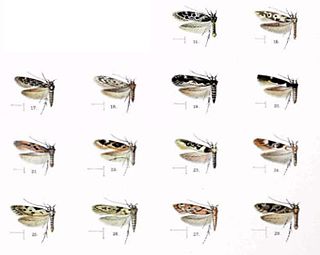Distribution
It was described from the Hawaiian islands of Oahu and Hawaii. Zimmerman opines it may be an introduced species. [1] This is due to remarks by Swezey when he collected the types for the taxon Batrachedra cuniculator near Honolulu. According to him it was odd that he had not noticed the species at an earlier date, [5] despite having lived in Hawaii for a few years.
When Zimmerman moved that taxon to his reclassified Chedra microstigma, he further remarked that besides the two species he had classified as Chedra, the genus Chedra was at that point only known from the New World, which meant the presence of the genus on Hawaii could be considered a biogeographic oddity. [1] At present, however, a new species has been discovered in the Philippines, C. fimbristyli, which is certainly native to those islands. [6] Zimmerman further theorised that the mode of invasion may have been the U.S. Army, which posted a large amount of horses and mules on Oahu after the USA usurped the native government in 1893, and imported a large amount of hay and silage from the West Coast of North America as provender for this stock, in which stalks the caterpillars may have hitched a ride. Note, however, that this was only around a decade before Lord Walsingham collected his type series in the island interior. [1]

The Batrachedridae are a small family of tiny moths. These are small, slender moths which rest with their wings wrapped tightly around their bodies.

Batrachedra is the largest genus in the moth family Batrachedridae, with representatives all over the world. The early stages of most species are unknown. The genus name is derived from the Greek words batrachos, 'frog', and edra, 'seat', referring to the frog-like resting posture of the adult moths. As of 2018 at least some 114 species are known to belong to the genus.

Chedra is a genus of tiny moths, belonging to the family Batrachedridae.
Macraesthetica is a monotypic moth genus belonging to the subfamily Olethreutinae of the family Tortricidae. The genus was erected by Edward Meyrick in 1932. It contains only one species, Macraesthetica rubiginis, which is only known from the Hawaiian island of Oahu. The species was first described by Lord Walsingham in 1907.
Mantua is a monotypic moth genus belonging to the subfamily Tortricinae of the family Tortricidae. The genus was first described by Elwood Zimmerman in 1978. Its only species, Mantua fulvosericea, was first described by Lord Walsingham in 1907. It is endemic to the Hawaiian islands of Kauai, Oahu, Molokai and Lanai.
Hyposmocoma argyresthiella is a species of moth of the family Cosmopterigidae. It was first described by Lord Walsingham in 1907. It is endemic to the Hawaiian islands of Kauai, Oahu, Molokai and Hawaii. The type locality is Kaawaloa, Kona, where it was collected at an elevation above 2,000 feet (610 m).

Hyposmocoma ochreovittella is a species of moth of the family Cosmopterigidae. It was first described by Lord Walsingham in 1907. It is endemic to the island of Hawaii. The type locality is Kona, where it was collected at an elevation of 4,000 feet (1,200 m).

Hyposmocoma ossea is a species of moth of the family Cosmopterigidae. It was first described by Lord Walsingham in 1907. It is endemic to the island of Hawaii. The type locality is Kona, where it was collected at an elevation of 4,000 feet (1,200 m).

Hyposmocoma radiatella is a species of moth of the family Cosmopterigidae. It was first described by Lord Walsingham in 1907. It is endemic to the Hawaiian islands of Kauai, Oahu, Molokai and Hawaii. The type locality is Kona, where it was collected at an elevation of 4,000 feet (1,200 m).

Hyposmocoma scandens is a species of moth of the family Cosmopterigidae. It was first described by Lord Walsingham in 1907. It is endemic to the island of Hawaii. The type locality is Kona, where it was collected at an elevation of 4,000 feet (1,200 m).

Hyposmocoma semifuscata is a species of moth of the family Cosmopterigidae. It was first described by Lord Walsingham in 1907. It is endemic to the island of Hawaii. The type locality is Kona, where it was collected at an elevation between 2,000 and 4,000 feet.

Hyposmocoma tricincta is a species of moth of the family Cosmopterigidae. It was first described by Lord Walsingham in 1907. It is endemic to the island of Hawaii. The type locality is Kona, where it was collected at an elevation of 2,000 feet (610 m).

Hyposmocoma calva is a species of moth of the family Cosmopterigidae. It was first described by Lord Walsingham in 1907. It is endemic to the island of Hawaii. The type locality is Kona, where it was collected at an elevation of 4,000 feet (1,200 m).

Hyposmocoma liturata is a species of moth of the family Cosmopterigidae. It was first described by Lord Walsingham in 1907. It is endemic to the Hawaiian islands of Oahu and Hawaii. The type locality is Kona, where it was collected at an elevation of 4,000 feet (1,200 m).

Hyposmocoma nebulifera is a species of moth of the family Cosmopterigidae. It was first described by Lord Walsingham in 1907. It is endemic to the Hawaiian island of Oahu. The type locality is the Waianae Range, where it was collected at an elevation of 2,000 feet (610 m).

Hyposmocoma similis is a species of moth of the family Cosmopterigidae. It was first described by Lord Walsingham in 1907. It is endemic to the island of Hawaii. The type locality is Kona, where it was collected at an elevation of 4,000 feet (1,200 m).

Hyposmocoma tetraonella is a species of moth of the family Cosmopterigidae. It was first described by Lord Walsingham in 1907. It is endemic to the island of Hawaii. The type locality is Kona, where it was collected at an altitude of 4,000 feet (1,200 m).
Anatrachyntis rileyi, the pink cornworm, pink bud moth or pink scavenger, is a species of moth of the family Cosmopterigidae, the cosmet moths. It was first described by Lord Walsingham in 1882 from the southern United States, but it is probably an introduction to North America. It is found in much of the warm or tropical areas of the world, including northern Australia, the Galápagos Islands, Hawaii, the Antilles, South America and Mauritius.
Chedra microstigma is a tiny moth of the family Batrachedridae described in 1907. It has only been found on Oahu. It has been found feeding on sedges, plants belonging to the Cyperaceae family, and its larvae host at least three species of parasitoids in Hawaii.
Batrachedrodes is a genus of moths of the Momphidae family. All species of this genus are endemic to the Hawaiian Islands.










